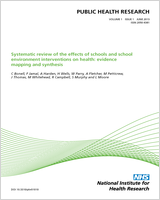Included under terms of UK Non-commercial Government License.
NCBI Bookshelf. A service of the National Library of Medicine, National Institutes of Health.
Bonell C, Dickson K, Hinds K, et al. The effects of Positive Youth Development interventions on substance use, violence and inequalities: systematic review of theories of change, processes and outcomes. Southampton (UK): NIHR Journals Library; 2016 May. (Public Health Research, No. 4.5.)

The effects of Positive Youth Development interventions on substance use, violence and inequalities: systematic review of theories of change, processes and outcomes.
Show details- Study location (country, area of country)
- Not stated
- Details
- The nature of the intervention(s)/components and how it was delivered to intervention group(s)
- Not stated
- Details
- The nature of the intervention(s)/components delivered to control group(s)
- Waitlist/delayed treatment
- Attention placebo/alternative intervention (please specify)
- Use if the comparison group receives a different intervention to the treatment group that is not the same as usual care and which has different aims to the main intervention
- Usual treatment/care, with assignment
- Matched group from target population or other inactive, without assignment
- How intervention was developed
- Not stated
- Details
- Timing of interventions
- Not stated
- Details
- Provider organisation description
- Not stated
- Details
- Target population
- Not stated
- Details
- Timing of outcome evaluation
- Not stated
- Details
- Outcome evaluation study design
- RCT
- nRCT
- Unit of allocation
- Individual
- Other (please specify)
- Generation of allocation sequence: any stratification, minimisation, etc.?
- Not applicable
- Not stated
- No
- YesGuidance: for example, the investigators describe a random component in the sequence generation process such as: referring to a random number table; using a computer random number generator; coin tossing; shuffling cards or envelopes; throwing dice; drawing of lots; minimisation.Note: minimisation may be implemented without a random element and this is considered equivalent to being random.
- Concealment of allocation (provide details)
- Not applicable
- Not stated
- No
- YesGuidance: for example, participants and investigators enrolling participants could not foresee assignment because one of the following, or an equivalent method, was used to conceal allocation: central allocation (including telephone, web-based and pharmacy-controlled randomisation); sequentially numbered drug containers of identical appearance; sequentially numbered, opaque, sealed envelopes.
- Blinding of intervention provider, outcome assessor
- Not stated
- No
- Yes
- Sample size, overall response rates at baseline
- Not stated
- Details
- Sample size, overall response rates at follow-up
- Not stated
- Details
- Sociodemographic characteristics at baseline/follow-up
- Not stated
- Details
- Were baseline equivalence/differences between arms reported?
- Yes
- No
- How were differences between intervention and comparison groups controlled?
- Not applicable (e.g. RCT)
- Matching (please specify)
- Adjustment (please specify)
- Not controlled
- Not stated/Not clear (please specify)
- Outcome measures (1): for each one answer the following
- Description
- Pre-hypothesisation
- – Primary outcome
- – Secondary outcome
- – Other
- – No
- Evidence of reliability/validity (provide details)
- Yes
- No
- Data collection methods
- Not stated
- Details
- Baseline response rate
- Not stated
- Details
- Follow-up response rate
- Not stated
- Details
- Rates of outcome by arm at follow-up (this is for each outcome, by intervention group and control group – differing from overall follow-up rates)
- Not stated
- Details
- Effect sizes
- OverallGuidance: if multiple choose ITT, adjusted analysis accounting for any clustering
- by gender
Guidance: if multiple choose ITT, adjusted analysis accounting for any clustering- by age
Guidance: if multiple choose ITT, adjusted analysis accounting for any clustering- by SES
Guidance: if multiple choose ITT, adjusted analysis accounting for any clustering- by ethnic subgroup
Guidance: if multiple choose ITT, adjusted analysis accounting for any clustering- No effect size?
- Study analysis was intention-to-treat?
- Not stated
- No
- Yes
- Study analysis appropriately accounted for clustering
- Not stated
- No
- Yes
- Study analysis adjusted for confounders
- Not stated
- No
- Yes
- Data extraction tool for outcome evaluations - The effects of Positive Youth Dev...Data extraction tool for outcome evaluations - The effects of Positive Youth Development interventions on substance use, violence and inequalities: systematic review of theories of change, processes and outcomes
Your browsing activity is empty.
Activity recording is turned off.
See more...